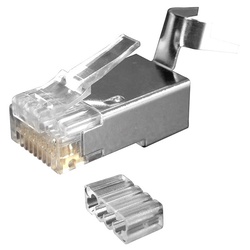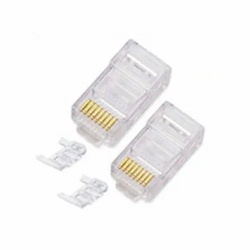
Generic Network Crimping Tool
A generic network crimping tool is a handheld tool designed to crimp or terminate network cables with various connectors, including RJ45, RJ11, and RJ12. These connectors are commonly used in Ethernet, telephone, and other networking applications.
- Multi-Connector Compatibility: The tool is compatible with various connector types, including RJ45 (8P8C), RJ11 (6P4C), and RJ12 (6P6C), allowing you to work with different networking and telecommunication cables.
- Ratcheting Mechanism: Many crimping tools feature a ratcheting mechanism that provides consistent and precise crimping force. This mechanism ensures that each crimp is secure and reliable, minimizing the risk of faulty connections.
- Multiple Functions: In addition to crimping, some tools may offer additional functions such as wire stripping and cutting. These integrated features allow you to strip the outer insulation of the cable and trim excess wire, providing convenience and efficiency in one tool.
- Interchangeable Jaws: Some crimping tools come with interchangeable jaws that can be easily swapped out to accommodate different connector types. This feature eliminates the need for multiple tools, saving space and cost.
| SKU | 1278 |
|---|
Reviews
This product does not have any reviews yet.
Add your reviewDescription
Generic Network Crimping Tool
A generic network crimping tool is a handheld tool designed to crimp or terminate network cables with various connectors, including RJ45, RJ11, and RJ12. These connectors are commonly used in Ethernet, telephone, and other networking applications.
The crimping tool typically consists of a sturdy handle with two or three jaws at the front end. Each jaw is specifically designed to accommodate a particular connector type. The jaws have a series of small metal blades or pins that are used to securely attach the connectors to the cable.
To use the crimping tool, you would strip the outer insulation of the cable to expose the individual wires inside. The wires are then arranged according to the appropriate wiring scheme for the connector type. Once the wires are properly aligned, the connector is placed onto the cable end. The crimping tool is then used to press the blades or pins into the connector, creating a strong and reliable connection between the wires and the connector.
The RJ45 connector is commonly used in Ethernet networking and has eight pins arranged in a rectangular shape. It is used for terminating Cat5, Cat5e, Cat6, and Cat6a cables.
The RJ11 and RJ12 connectors are typically used for telephone and analog modem connections. They have six pins arranged in a similar rectangular shape, with the RJ12 connector being slightly larger than the RJ11.
A generic network crimping tool is versatile and compatible with all three connector types, allowing you to crimp and terminate cables for different networking applications. It is an essential tool for network technicians, IT professionals, and DIY enthusiasts involved in network installations, repairs, or cable customizations.
Features:
-
Multi-Connector Compatibility: The tool is compatible with various connector types, including RJ45 (8P8C), RJ11 (6P4C), and RJ12 (6P6C), allowing you to work with different networking and telecommunication cables.
-
Ratcheting Mechanism: Many crimping tools feature a ratcheting mechanism that provides consistent and precise crimping force. This mechanism ensures that each crimp is secure and reliable, minimizing the risk of faulty connections.
-
Multiple Functions: In addition to crimping, some tools may offer additional functions such as wire stripping and cutting. These integrated features allow you to strip the outer insulation of the cable and trim excess wire, providing convenience and efficiency in one tool.
-
Interchangeable Jaws: Some crimping tools come with interchangeable jaws that can be easily swapped out to accommodate different connector types. This feature eliminates the need for multiple tools, saving space and cost.
-
Ergonomic Design: A comfortable and ergonomic handle design reduces hand fatigue during extended use. The handles may have non-slip grips or rubberized coatings for better control and stability.
-
Durable Construction: Network crimping tools are typically made of durable materials such as hardened steel or alloy, ensuring longevity and resistance to wear and tear. This construction allows the tool to withstand repeated use and maintain its functionality.
-
Compact and Portable: The tool is compact and lightweight, making it easy to carry and store in a tool bag or toolbox. Its portable nature enables you to perform network cable terminations or repairs on-site or in various locations.
-
Built-in Blade and Pin Cutters: Some crimping tools may feature built-in cutters specifically designed to trim the excess wire from the connectors. This feature eliminates the need for separate wire cutters, streamlining the termination process.
-
Adjustable Crimping Pressure: Certain crimping tools offer adjustable crimping pressure settings. This feature allows you to fine-tune the crimping force based on the cable and connector type, ensuring optimal performance and avoiding over or under-crimping.
-






